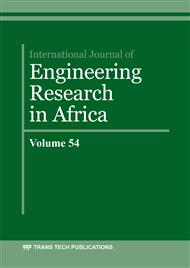[1]
M. Henze, P. Harremoës, J. la Cour Jansen, E. Arvin, Wastewater Treatment: Biological and Chemical Processes, third ed., Springer-Verlag, Berlin, (2002).
DOI: 10.1007/978-3-662-04806-1
Google Scholar
[2]
M.M. El-Seddik, M.M. Galal, A.G. Radwan, H.S. Abdel-Halim, Fractional-Order Model (FOM) for high-strength substrate biodegradation in conventional UASB reactor, Biochem. Eng. J. 133 (2018) 39-46. https://doi.org/10.1016/j.bej.2018.01.032.
DOI: 10.1016/j.bej.2018.01.032
Google Scholar
[3]
K. Krysiak-Baltyn, G.J.O. Martin, A.D. Stickland, P.J. Scales, S.L. Gras, Simulation of phage dynamics in multi-reactor models of complex wastewater treatment systems, Biochem. Eng. J. 122 (2017) 91-102. https://doi.org/10.1016/j.bej.2016.10.011.
DOI: 10.1016/j.bej.2016.10.011
Google Scholar
[4]
D. Jenkins, J. Wanner, Activated sludge: 100 years and Counting, IWA Pub, London, (2014).
Google Scholar
[5]
D.j. Kapumbe, L. Min, X. Zhang, M.A. Kisoholo, L. Yongfeng, Modeling and simulation of membrane bioreactor model based on ASM3 for domestic wastewater treatment, Appl. Ecol. Environ. Res. 17 (2019) 11395-11407. http://dx.doi.org/10.15666/aeer/1705_1139511407.
DOI: 10.15666/aeer/1705_1139511407
Google Scholar
[6]
S.W. How, J.H. Sin, S.Y.Y. Wong, P.B. Lim, A.M. Aris, G.C. Ngoh, T. Shoji, T.P. Curtis, A.S.M. Chua, Characterization of slowly-biodegradable organic compounds and hydrolysis kinetics in tropical wastewater for biological nitrogen removal. Water Sci. Technol. 81 (2020) 71–80. https://doi.org/10.2166/wst.2020.077.
DOI: 10.2166/wst.2020.077
Google Scholar
[7]
I.I. Shpakovskaya and D.M. Loseva, Simulation of Biological Wastewater Treatment of Oil Refineries and Oil Producing Enterprises, 2019 IEEE Conference of Russian Young Researchers in Electrical and Electronic Engineering (EIConRus), Saint Petersburg and Moscow, Russia, (2019) 677-680,.
DOI: 10.1109/eiconrus.2019.8656702
Google Scholar
[8]
N.G. Mostafa, Development of a generalized reduced ASM3 and IASM3-S for municipal-industrial wastewater application, PhD thesis, Cairo University, Giza, Egypt, (2016).
Google Scholar
[9]
N.G. Mostafa, M.M. Galal, A.G. Radwan, E.M. Rashed, Comparison and Database Development of Four Recent ASM3 Model Extensions, J. Environ. Eng. (2016).
DOI: 10.1061/(asce)ee.1943-7870.0001087
Google Scholar
[10]
W. Wu, Development of a plant-wide steady-state wastewater treatment plant design and analysis program, University of Cape Town, (2015).
Google Scholar
[11]
M. Henze, W. Gujer, T. Mino, M. van Loosdrecht, Activated sludge models ASM1, ASM2, ASM2d and ASM3, IWA Publishing, London, U.K, (2000).
DOI: 10.2166/9781780402369
Google Scholar
[12]
Y. Lv, S. Zhang, K. Xie, G. Liu, L. Qiu, Y. Liu, Y, Zhang, Establishment of nitrous oxide (N2O) dynamics model based on ASM3 model during biological nitrogen removal via nitrification, Environ. Technol., (2020).
DOI: 10.1080/09593330.2020.1822447
Google Scholar
[13]
M. Buaisha, S. Balku, S. Özalp-Yaman, Heavy Metal Removal Investigation in Conventional Activated Sludge Systems, Civ. Eng. J., 6(2020).
DOI: 10.28991/cej-2020-03091484
Google Scholar
[14]
M. Henze, Biological Wastewater Treatment: Principles, Modelling and Design, IWA publishing, London, UK, (2008).
Google Scholar
[15]
Y. Peng, W. Zeng, S. Wang, DO concentration as a fuzzy control parameter for organic substrate removal in SBR processes, Environ. Eng. Sci. 21 (2004) 606-616.
DOI: 10.1089/ees.2004.21.606
Google Scholar
[16]
M. Singh, R.K, Srivastava, Sequencing batch reactor technology for biological wastewater treatment: a review, ASIA-PAC J. Chem. Eng. (2011).
Google Scholar
[17]
O. Sánchez,N. Bernet, J.P. Delgenès, Effect of dissolved oxygen concentration on nitrite accumulation in nitrifying sequencing batch reactor, Water Environ. Res. 79 (2007) 845-850.
DOI: 10.2175/106143007x175807
Google Scholar
[18]
R.C. Jin, P. Zheng, A.H. Hu, Mahmood, B.L. Hu, G. Jilani, Performance comparison of two anammox reactors: SBR and UBF, Chem. Eng. J. 138 (2008) 224-230.
DOI: 10.1016/j.cej.2007.06.038
Google Scholar
[19]
D. Obaja, S. Macé, J. Mata-Alvarez, Biological nutrient removal by a sequencing batch reactor (SBR) using an internal organic carbon source in digested piggery wastewater, Bioresour. Technol. 96 (2005) 7–14.
DOI: 10.1016/j.biortech.2004.03.002
Google Scholar
[20]
T. Jiang, X. Liu, M.D. Kennedy, J.C. Schippers, P.A. Vanrolleghem, Calibrating a side-stream membrane bioreactor using Activated Sludge Model No. 1, Water Sci. Technol. 52 (2005) 359–367.
DOI: 10.2166/wst.2005.0712
Google Scholar
[21]
P.J. Roeleveld, M.C.M. van Loosdrech, Experience with guidelines for wastewater characterisation in the Netherlands, Water Sci. Technol. 45(2002) 77-87.
DOI: 10.2166/wst.2002.0095
Google Scholar



